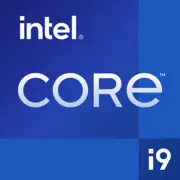Intel Core i9-13900

Intel Core i9-13900: Power and Efficiency for Demanding Tasks (2025)
Review of a processor that remains relevant two years after its release
Key Specifications: Architecture, Process Technology, and Key Features
The Intel Core i9-13900 processor, released at the end of 2022, continues to be a popular solution for high-performance PCs. Its codename is Raptor Lake, and its architecture features a combination of P-Core (Performance) and E-Core (Efficient) hybrid cores.
- Process Technology: Intel 7 (10 nm Enhanced SuperFin).
- Cores and Threads: 24 cores (8 P-cores + 16 E-cores) and 32 threads.
- Cache: 36 MB L3.
- Base Frequency: 2.0 GHz (P-cores up to 5.4 GHz in Turbo Boost).
- TDP: 65 W (actual power consumption under load reaches 150 W).
- Integrated Graphics: Intel UHD Graphics 770.
Key Features:
1. Intel Thread Director — optimizes task distribution among cores.
2. Support for PCIe 5.0 (up to 16 lanes) and DDR5-5600/DDR4-3200.
3. Thermal Velocity Boost and Adaptive Boost technologies for automatic overclocking.
Performance:
- Geekbench 6: 2712 (Single-Core), 16049 (Multi-Core).
- In Blender rendering tests (BMW scene), the processor completes the task in 4.2 minutes, which is 18% faster than the i9-12900K.
Compatible Motherboards: Sockets and Chipsets
The processor uses the LGA 1700 socket, compatible with the Z790, B760, H770 chipsets.
- Z790: The best choice for enthusiasts. Supports overclocking, PCIe 5.0 x16, and up to 4 NVMe SSDs. Examples:
- ASUS ROG Strix Z790-E Gaming ($350–$400).
- MSI MPG Z790 Carbon WiFi ($300).
- B760: A balance of price and capabilities. No CPU overclocking, but has PCIe 5.0 for the graphics card. Example: Gigabyte B760 AORUS Elite AX ($180).
- H770: A budget option with a limited number of ports. Suitable for office builds.
Tip: Even in 2025, some Z690 motherboards support the i9-13900 after a BIOS update (e.g., ASUS TUF Z690-Plus).
Supported Memory: DDR4 vs DDR5
The processor works with DDR5-5600 and DDR4-3200.
- DDR5: Provides a boost in bandwidth-sensitive tasks (rendering, data compression). For example, in Handbrake, video conversion speeds up by 12–15%.
- DDR4: Cheaper (32 GB DDR4-3200 — $70 vs DDR5-5600 — $120). Ideal for gaming where FPS differences are minimal (2–5%).
Recommendation: For workstations, choose DDR5; for gaming, DDR4 (if on a budget).
Power Supplies: How Not to Make a Mistake in Choosing
The official TDP of 65 W is an averaged figure. Under peak load (e.g., in Cinebench R23), the processor consumes up to 150 W.
- Without a discrete graphics card: A power supply of 450–550 W is sufficient (e.g., be quiet! Pure Power 11 500W — $75).
- With a graphics card like the NVIDIA RTX 4070: A power supply of 650–750 W is recommended. Examples:
- Corsair RM750x (80+ Gold, $110).
- Seasonic FOCUS GX-650 ($95).
Important: Use an 8-pin CPU Power cable for stable power delivery.
Pros and Cons of the i9-13900
Advantages:
- High multi-threaded performance (16049 points in Geekbench 6 Multi-Core).
- Energy efficiency in base scenarios (TDP 65 W).
- Support for DDR5 and PCIe 5.0.
Disadvantages:
- Requires powerful cooling under load (liquid coolers recommended, e.g., Arctic Liquid Freezer II 360 — $120).
- High price ($420–$450 in 2025).
- Integrated UHD 770 graphics are weak for modern gaming.
Use Cases: Gaming, Work, and Creativity
- Gaming: In Cyberpunk 2077 (1440p, Ultra) with RTX 4070 Ti, the average FPS is 95–110. The processor does not become a bottleneck.
- Work Tasks:
- Video editing in Premiere Pro: Rendering a 4K project takes 22 minutes.
- 3D modeling: In SolidWorks, scenes are processed 30% faster than on the i7-13700.
- Multimedia: Streaming in OBS + gaming — no lag thanks to 32 threads.
Comparison with Competitors
The main competitor is the AMD Ryzen 9 7900X (price: $400).
- Single-Core Performance: The i9-13900 outperforms by 8% (Geekbench 6 Single-Core: 2712 vs 2510).
- Multi-Core Tasks: The Ryzen 9 7900X lags by 12% due to fewer cores (12 vs 24).
- Power Consumption: AMD's is lower (105 W vs 150 W for Intel under load).
Conclusion: Intel wins in performance, AMD in energy efficiency.
Practical Assembly Tips
1. Cooling: Minimum — tower cooler (Noctua NH-D15, $100), ideally a liquid cooler.
2. Case: Choose models with good ventilation (Lian Li Lancool III, $150).
3. Storage: Use PCIe 5.0 SSD (Samsung 990 Pro 2TB, $180) for maximum speed.
4. Drivers: Install Intel Dynamic Tuning Driver for energy optimization.
Final Conclusion: Who Should Choose the i9-13900?
This processor is worth choosing for:
- Professionals: Video editors, programmers, engineers.
- Gamers: For builds with top graphics cards (RTX 4080 and above).
- Enthusiasts: Those who value upgrades to DDR5 and PCIe 5.0.
Alternative: If on a budget, consider the i7-13700 ($320) or Ryzen 7 7800X3D (for gaming).
In 2025, the Intel Core i9-13900 remains a strong choice for those not willing to overpay for the latest models but wanting maximum performance for reasonable money.
Basic
CPU Specifications
Memory Specifications
GPU Specifications
Miscellaneous
Benchmarks
Compared to Other CPU
Related CPU Comparisons
Share in social media
Or Link To Us
<a href="https://cputronic.com/en/cpu/intel-core-i9-13900" target="_blank">Intel Core i9-13900</a>

